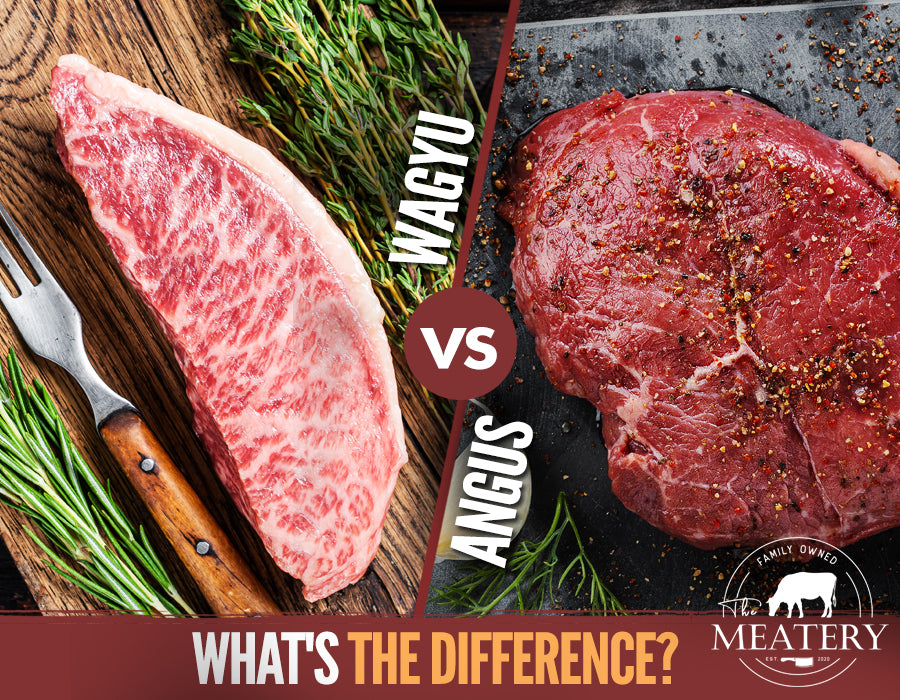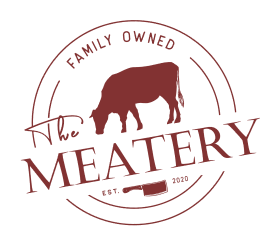Do you know the difference between Wagyu and Angus beef? If not, you're not alone! A lot of people don't know the difference, but it's an important distinction to make when you're shopping for a high-end steak. Wagyu beef is known for its tenderness and rich marbling, while Angus beef is known for its beefy flavor. In this blog post, we will discuss the differences between Wagyu and Angus beef, and help you decide which cut is right for you!
Wagyu vs. Angus Beef
Wagyu beef is a type of Japanese beef that is prized for its marbling. Wagyu cattle are bred to have intense marbling, which results in a steak that is incredibly tender and juicy. The downside of Wagyu beef is that it can be quite expensive. Angus beef, on the other hand, is a type of American beef that is known for its flavor. Angus cattle are not bred for marbling, but they do have a lot of muscle, which gives their meat a robust flavor. Angus beef is also less expensive than Wagyu beef.
Choosing Your Steak
So, which one should you choose? It really depends on what you're looking for in a steak! If you're looking for something luxurious with incredibly rich flavor then Wagyu beef is the way to go. If you're looking for something with a strong beef flavor, then Angus beef is the way to go.
Choosing Your Cut of Steak
Once you've decided on Wagyu or Angus, next up you need to select which cut you want to order. The three most popular steaks sold are Ribeyes, Filet Mignon, and New York Strip.
A Ribeye steak is a type of steak that comes from the rib section of the cow. Ribeye steaks are known for their rich flavor and heavy marbling. Customers that don't like a steak with a lot of fat should avoid Ribeyes.
Filet Mignon comes from the tenderloin section of the cow. Filet Mignon steaks are known for their incredible tenderness, as it is taken from the least-worked muscle on the cow's body. The downside of Filet Mignon is that it can lack flavor when compared to other types of steak.
So, which one should you choose? It depends on what you're looking for in a steak! If you're looking for something rich and flavorful, then Ribeye is the way to go. If you're looking for something incredibly tender, then Filet Mignon is the clear winner. And if you're looking for something that is a good balance of flavor and tenderness, then we encourage you to try a New York Strip.
Tips for Buying High-Quality Wagyu and Angus Beef
When it comes to purchasing premium beef, whether Wagyu or Angus, the quality of your steak can make all the difference in your dining experience. Here are some expert tips to help you choose the best cuts:
1. Check the Marbling Grade for Wagyu Beef
Marbling is one of the key indicators of high-quality Wagyu beef. Look for steaks with fine, evenly distributed marbling throughout the meat, which indicates a higher fat content that melts during cooking, enhancing the flavor and tenderness. Japanese Wagyu is graded on a scale from A1 to A5, with A5 being the highest grade. Always opt for A4 or A5 grades to experience the full richness of Wagyu.
2. Verify the Source and Certification
Authentic Wagyu and Angus beef come from reputable farms and should carry proper certifications. For Wagyu, check if the beef is certified Japanese Wagyu, as this ensures it comes from purebred Japanese cattle. For Angus, look for beef labeled Certified Angus Beef (CAB), which follows strict standards for marbling, maturity, and tenderness.
3. Choose the Right Cut for Your Needs
Different cuts offer distinct experiences. Ribeyes are rich and fatty, Filet Mignon is incredibly tender, and New York Strips offer a balance of flavor and tenderness. Match the cut to your taste preference to get the most out of your purchase.
4. Inspect the Color and Texture of the Meat
High-quality beef should have a bright, vibrant color — Wagyu typically has a rich cherry-red hue, while Angus should be deep red with visible muscle structure. The texture should be firm but not tough, and the fat should appear creamy white rather than yellow.
5. Buy from Trusted Purveyors Like The Meatery
Where you buy your beef is just as important as the beef itself. Purchasing from reputable butchers and specialty shops ensures you receive the highest quality meat. The Meatery is a trusted source for premium Wagyu and Angus beef, offering carefully sourced products from reputable farms that adhere to strict standards of quality, sustainability, and ethical farming. The Meatery's commitment to transparency and exceptional customer service ensures that you get the perfect cut every time, whether you're looking for luxurious Wagyu or flavorful Angus.
6. Check for Proper Aging
Proper aging enhances the flavor and tenderness of both Wagyu and Angus beef. Dry-aged beef develops a more intense flavor, while wet-aged beef offers a slightly more subtle taste but still maintains tenderness. Ask your purveyor about the aging process to ensure you’re getting the best possible cut.
7. Look for Vacuum-Sealed Packaging
Beef that is vacuum-sealed retains its freshness longer and helps prevent freezer burn. This packaging method is particularly important for preserving the quality of Wagyu, as its high fat content can spoil quickly if not properly sealed.
8. Ask About Feeding Practices
The diet of the cattle significantly impacts the flavor of the beef. Wagyu cattle are often fed a specialized diet that includes grains, which enhances marbling, while Angus cattle are typically grass-fed and finished on grain to boost flavor. Inquire about feeding practices to align your choice with your dietary preferences and flavor expectations.
By following these tips, you can ensure that the Wagyu or Angus beef you purchase is of the highest quality, delivering the best possible steak experience every time.
Expert Tips: Cooking Wagyu vs. Angus Steaks to Perfection
Cooking Wagyu and Angus steaks requires different techniques to bring out the best in each cut. Here are some expert tips to help you cook these premium steaks to perfection:
1. Cooking Wagyu: Low and Slow for Maximum Tenderness
Wagyu beef's high marbling means it cooks differently than other steaks. To preserve its rich, buttery texture, cook Wagyu steaks over low to medium heat. The fat in Wagyu melts quickly, so avoid high heat that can cause flare-ups and result in uneven cooking. Use a cast iron skillet or a grill with a flat top to evenly distribute heat. For a truly luxurious experience, try The Meatery’s A5 Japanese Wagyu Ribeye — its intense marbling and delicate texture make it perfect for this low-and-slow cooking approach, ensuring a melt-in-your-mouth finish every time.
Expert Tip: Let the steak come to room temperature before cooking, and use minimal seasoning—salt and pepper are often enough to enhance its natural flavor. Sear each side for 1-2 minutes to create a crispy crust, then finish cooking slowly to your desired doneness, typically aiming for rare to medium-rare.
2. Resting is Essential for Wagyu
Due to its rich fat content, Wagyu needs a longer resting period after cooking to allow the juices to redistribute throughout the steak. Rest the steak for at least 5-10 minutes before slicing to ensure maximum juiciness.
3. Cooking Angus: High Heat for a Bold, Beefy Flavor
Angus beef benefits from high-heat cooking methods that create a flavorful crust while keeping the inside juicy. For cuts like Ribeye or New York Strip, use a hot grill, skillet, or broiler to sear the steak, locking in the robust, beefy flavor Angus is known for.
Expert Tip: Season generously with salt, pepper, and your favorite steak rubs. For thicker cuts, use the reverse sear method: start cooking the steak over indirect heat until it reaches an internal temperature just shy of your desired doneness, then finish with a high-heat sear.
4. Rest Angus, But Not Too Long
Angus steaks should rest for about 5 minutes after cooking. This allows the juices to settle without losing too much heat, ensuring each bite is as flavorful as possible. For best results, try USDA Prime Angus Ribeye, which combines rich marbling with a robust flavor profile—just the right balance for high-heat searing and a short resting time that locks in those delicious juices.
5. Slicing: The Right Way Matters
For both Wagyu and Angus, always slice against the grain to ensure tenderness. This technique shortens the muscle fibers, making each bite easier to chew and more enjoyable.
6. Use Simple Finishes to Enhance, Not Overpower
With premium beef like Wagyu and Angus, simplicity is key. A light drizzle of high-quality olive oil, a pat of herb butter, or a sprinkle of flaky sea salt can elevate the steak without masking its natural flavors. Avoid heavy sauces that can overpower the beef’s unique taste.
7. Temperature Guidelines: Know Your Doneness
-
Rare (120-125°F): Ideal for Wagyu to experience the full richness of its marbling.
-
Medium-Rare (130-135°F): A perfect balance of tenderness and flavor for both Wagyu and Angus.
-
Medium (140-145°F): Still juicy, particularly suited for thicker Angus cuts.
Cooking Wagyu and Angus steaks to perfection is all about respecting the qualities that make each unique. By following these tips, you’ll bring out the best in every steak, turning your meal into a restaurant-quality experience at home.
The Meatery: Your Go-To Source for Premium Wagyu and Angus Beef
Choosing between Wagyu and Angus beef comes down to personal preference, as each offers unique qualities that cater to different palates. Wagyu boasts unparalleled tenderness and rich marbling, making it perfect for those seeking a luxurious experience, while Angus delivers bold, beefy flavors at a great value.
At The Meatery, we pride ourselves on providing only the highest quality beef sourced from reputable farms committed to ethical practices. Whether you're in the mood for a richly marbled Wagyu or the robust taste of Angus, our expert team is here to help you select the perfect cut to elevate your dining experience. Shop with confidence knowing that at The Meatery, you’re getting exceptional steak without the need to declare one "the best"—because the best is whatever you love.









